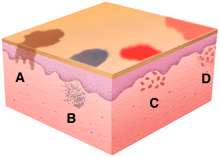
Watermelon: A Natural Viagra?
Researcher Says Popular Summer Fruit May Have Viagra-Like Effect on Blood Vessels
By Kathleen Doheny
WebMD Health News Reviewed by Brunilda Nazario, MD
July 1, 2008 -- Men hoping for some fireworks in their love life this Fourth of July may want to skip the burgers and beer at the barbecue and eat plenty of watermelon.
Watermelon may be a natural Viagra, says a researcher. That's because the popular summer fruit is richer than experts believed in an amino acid called citrulline, which relaxes and dilates blood vessels much like Viagra and other drugs meant to treat erectile dysfunction (ED).
"We have known that watermelon has citrulline," says Bhimu Patil, PHD, director of the Fruit and Vegetable Improvement Center at Texas A&M University, College Station. Until recently, he tells WebMD, scientists thought most of the citrulline was in the watermelon rind. "Watermelon has more citrulline in the edible part than previously believed," he says.
How could watermelon be a natural Viagra? The amino acid citrulline is converted into the amino acid arginine, Patil says. "This is a precursor for nitric oxide, and the nitric oxide will help in blood vessel dilation."
So, the burning question: How much watermelon does it take?
"That is a good question," Patil says. Unfortunately, "I don't have an answer for that."
He does know that a typical 4-ounce serving of watermelon (about 10 watermelon balls) has about 150 milligrams of citrulline. But he can't say how much citrulline is needed to have Viagra-like effects.
He's hopeful that someone will pick up on his research and study the fruit's effect on penile erections.
Watermelon's Viagra-Like Effects
On hearing about the Texas finding, Irwin Goldstein, MD, editor-in-chief of The Journal of Sexual Medicine, was underwhelmed. Suggesting a man feast on watermelon to boost performance, he says, "would be the equivalent of someone dropping a beer bottle in Minneapolis, where the Mississippi River starts, and hoping to see it make an impact on someone in New Orleans."
"To say that watermelon is Viagra-like is sort of fun," says Goldstein. "But to even vaguely hope that eating watermelon will alleviate ED is misleading."
"The vast majority of Americans produce enough arginine," adds Goldstein, medical director of Alvarado Hospital Medical Center, San Diego, and clinical professor of surgery, University of California San Diego School of Medicine. "Men with ED are not deficient in arginine."
Though arginine is required to make nitric oxide, and nitric oxide is required to dilate blood vessels and have an erection, "that doesn't mean eating something that is rich in citrulline will make enough arginine that it will lead to better penile erections," Goldstein says.
Goldstein has served as a consultant for many companies that make ED drugs.
Calling watermelon a natural Viagra is "clearly premature," says Roger Clemens, DrPH, adjunct professor of pharmacology and pharmaceutical sciences, University of Southern California, Los Angeles, and a spokesman for the Institute of Food Technologists.
Clemens studied the amino acid arginine himself, researching a supplement to improve vascular flow for patients with hardening of the arteries or atherosclerosis. He has since abandoned that line of research, he says.
It can require a lot of watermelon to boost blood levels of arginine, he adds. In a study published in 2007 in Nutrition, he says, volunteers who drank three 8-ounce glasses of watermelon juice daily for three weeks boosted their arginine levels by 11%.
Watermelon is low in calories and provides potassium and the phytonutrients lycopene and beta-carotene, in addition to the citrulline.
Clemens' advice on watermelon and the Fourth of July? "Put salt on it and enjoy."
Just don't expect fireworks anywhere but in the sky.













